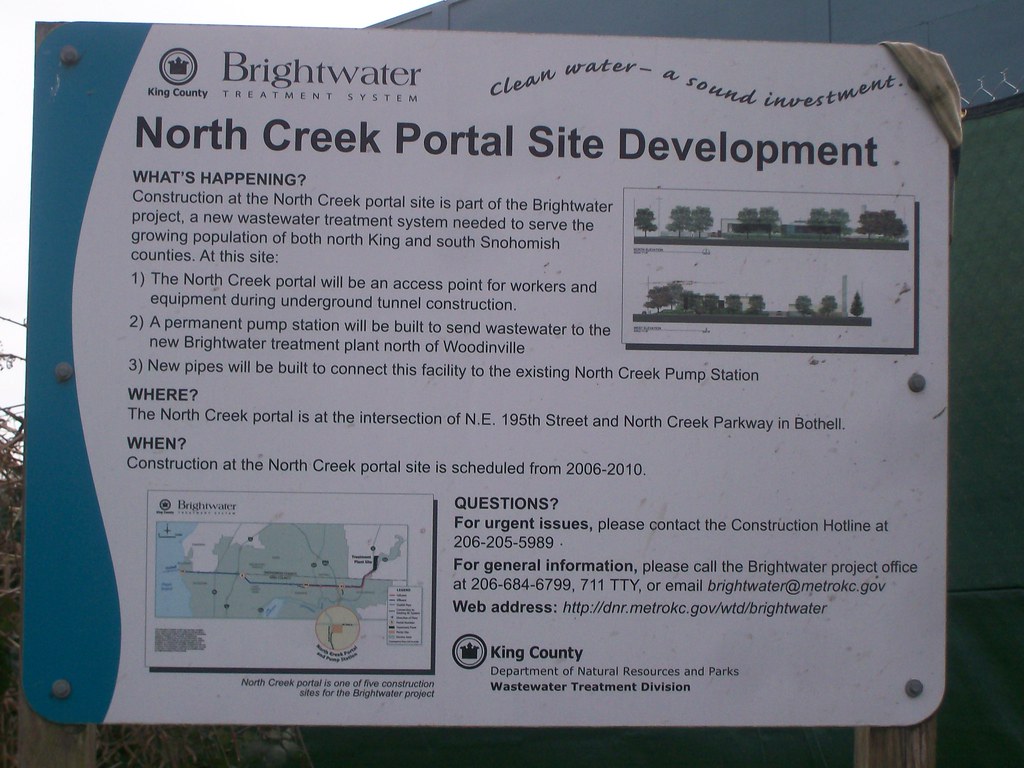 |
| Check out the dirt-dumping action! |
 |
| Sooper-seekrit projeckt revealed! Image credit Cujo. |
Cujo sent me this article in the Seattle Times that shows what happens when you drive a tunnel through gobs and oodles of glacial sediments: sinkholes. And how. Check this out:
 |
| Kenmore Sinkhole, image credit and copyright TunnelTalk |
Neither the owner nor the contractor would discuss the focus of their investigations, but these will likely look at several possible causes, including the experience of the slurry machine operator with the closed slurry system making it difficult to judge the amount of material being excavated during a shove. Another possible cause might be the presence of a large boulder in the face that stalled penetration without slowing extraction of material and caused over-excavation. A third possibility is the meeting of high artesian water pressure and its influence on the excavation cycle. [emphasis added]All of you geotypes are probably shouting, "Glacial erratic!" about now. Seattle's got lots, random boulders dropped by the Cordilleran Ice Sheet during its stay. According to the articles I found, the tunnel-boring machine's been encountering quite a bit of sandy soil, which it sometimes proceeds to remove too much of. Not to mention running in to boulders. Tunneling through all of that glacial outwash, till, and random erractics has got to be an absolute nightmare, and goes a long way toward explaining why the project's run over on both time and money.
TunnelTalk has a nice, simplified geologic cross-section showing what the excavators are dealing with here:
 |
| Image courtesy and copyright TunnelTalk |
This is something ordinary folk don't usually think about when contemplating infrastructure, when they contemplate it at all. But geology's critical when it comes to deciding where and how you're going to dig your tunnels things like wastewater lines. We don't have a lot of good choices here. The bedrock's down too deep in most places, the water table's high, and glacial deposits are difficult to deal with. Planners need to understand and deal with those issues so that the needs of the metropolis can be served. And this is a good dry run for the gargantuan tunnel they want to replace the Alaskan Way Viaduct with: without this, they may not have been alerted to the true scope of the problems they're going to face in sending a highway underground.
Oh, Seattle! You are beautiful, but when it comes to infrastructure, you're a right pain in the arse.







4 comments:
And if even a minor Earthquake occurs while anyone is down there replacing a cutting head... "buried alive" comes to mind.
and this is a good dry run for the gargantuan tunnel they want to replace the Alaskan Way Viaduct with:
Or, a harbinger of what a disaster that could turn out to be. My guess is that they're more familiar with what's under downtown Seattle, since people have been building large structures there since the beginning of the 20th Century. Still, it would be nice to know they were paying attention.
What a mess! Tunneling projects always seem to come in horribly late and massively over-budget; I suspect it's because there's always lots of pressure in the bidding phase to downplay the most serious problems the geology can cause.
Laying pipe in earthquake country below the water table in glacial sand and gravel deposits brings to mind two interesting terms:
inflow collection system inundation
-and-
old lace and arsenic
The first term refers to piping leaks that could cause headaches for the public wastewater treatment works (POTW) in coming years...
and the second refers to the unfortunate chemistry of wastewater nitrate leakage from damaged piping when the water table dips (seasonally) and results in arsenic release from sediment interstitial waters, which then enters said piping when the water table rises later in the year. Bangladeshi-style.
Post a Comment